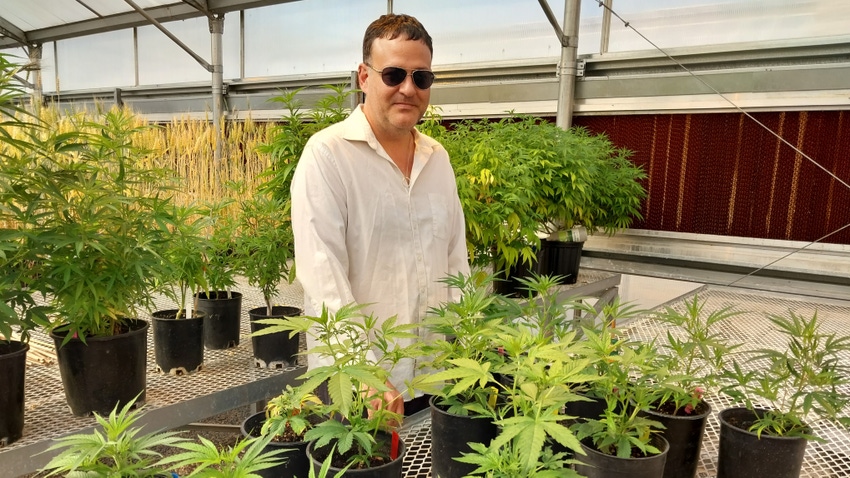
Forever in the shadow of marijuana, the fledgling industrial hemp industry is seeking to cut its own path in the marketplace. And some 70 researchers at Oregon State University are trying to help.
Hemp was long presented as the more legitimate side of cannabis – the non-psychoactive plant that could be consumed or used for fabric or construction materials. As more and more states began to legalize the recreational use of marijuana, a provision was included in the 2018 farm bill that allowed hemp to be produced nationwide for the first time in more than 80 years.
Hemp is a highly versatile crop that can be used in textiles, food, paper and construction materials, but until recently, it was predominantly grown for production of cannabidiol, or CBD, which has been widely touted for health and wellness benefits. According to 2020 U.S. Department of Agriculture crop acreage data, 62% of cultivated hemp was grown for CBD extraction.
But farmers soon found that demand for hemp CBD didn’t materialize, leaving piles of hemp biomass unsold and prompting Barron’s to label the product “a bust” in 2020.
“A lot of people jumped in two or three years ago, and the market tanked, so there was a reduction in production,” said Zhaohui Wu, a professor in OSU’s College of Business. “But now the commodity market is picking up.”
Enter OSU’s Global Hemp Innovation Center, which was launched in 2018 as the nation’s largest research center devoted to the study of hemp with nearly 20 academic departments contributing to the work. The center is gaining international recognition; its director, Jeffrey Steiner, recently spoke at the second iHemp Summit in New Zealand, and OSU hosted the Association for Advancement of Industrial Crops’ 34th annual meeting in late August.
Oregon a trailblazer
Oregon was a trailblazer in reintroducing hemp to American markets, authorizing its cultivation in 2009 and beginning to license growers in 2015. By 2018, the Beaver State ranked third in the U.S. in licensed hemp acres planted behind Montana and Colorado, according to the center’s website.
As the center explains, Oregon’s geographic location is optimal for hemp growth and unique hemp germplasm – the genetic material used for breeding – was developed in the state over the past several decades.
The center’s arrival five years ago was a reopening of sorts; the university hosted a national hemp research center from the 1880s until 1936, when the crop was banned because of its similarities with marijuana.
Hemp acreage in Oregon ballooned after the 2018 farm bill, from 7,808 acres planted in 2018 to more than 60,000, according to the state Department of Agriculture. But the popularity of the crop soon fizzled; only 3,112 acres are planted in Oregon this year, according to the state agency.
As a new crop, hemp lacks the research and market distribution of more established commodities, Wu said. That’s where OSU’s center comes in. Wu is working on supply-chain management, seeking to resolve the “chicken-and-egg issue” of smaller-sized producers selling to a still-undefined market, he said.
“Its use is no longer just CBD, but oil and fiber,” he said.
Despite its slow start, hemp as a feed grain and fiber material shows lots of promise, researchers say. Hemp stalks can be blended with lime to make hempcrete, a renewable alternative to concrete and plastic.
“BMW is using hemp to replace plastic, and Ford is using it,” Wu said.
Wu is also working on promoting diversity among producers. He’s exploring building a hemp production base along the Highway 97 corridor to help the region’s nine Native American tribes to diversify their economies from casinos.
“It’s a cultural artifact,” he said of hemp.
Many disciplines
Different colleges at OSU are studying aspects of hemp use and production according to their expertise, Wu said. For instance, pharmaceutical students are considering hemp’s uses in medicine; last year, researchers at OSU identified compounds in hemp as possible treatment for COVID-19.
Other scientists are feeding hemp byproducts to livestock. An OSU study last year found that spent hemp biomass – the main byproduct of the CBD extraction process – can be included in lamb diets without harming the animals’ health or meat quality. The research could help efforts to legalize spent hemp biomass as feed, as the U.S. Food and Drug Administration has so far blocked such a use because of the potential presence of the intoxicant tetrahydrocannabinol (THC).
“It’s a (newly) legalized commodity, so we’re still trying to figure out usage,” Wu said. “One of the problems is you’ll have a grower who will claim he’s growing hemp and grow marijuana in the middle.
“You have to test for THC level” to market hemp as feed, he said. “There are lots of hurdles.”
Hemp breeder Stephen Baluch joined OSU’s Department of Crop and Soil Science in July 2022. A former corn breeder for Monsanto and Dow Agrosciences, he moved to Oregon in 2016 and started breeding marijuana before switching to hemp five years ago.
Two uses
Using part of a greenhouse on the OSU campus and a plot at the university’s research farm in Monmouth, Ore., Baluch is looking at two potential uses of hemp – fiber and grains.
“Right now I’m generating seed so we can plant it next year,” Baluch said.
Hemp is a good source of human nutrition, high in omega-3 fatty acids, but its development as a food grain “is going to take a little bit to take off” because there isn’t the infrastructure to support it, he said. On the other hand, the future of hemp in fabrics and other materials is bright.
“Right now the fiber market is going at light speed and developing itself,” Baluch said. “The fiber that comes off it is strong. You can grow varieties that are very fine and you can make textiles.”
Hemp production may also be better for the environment. For one thing, it’s a rotation crop, , which could make it attractive to corn and other growers in the Midwest and Southeast, Wu said.
“With cotton, you have to spray chemicals on it,” Baluch said. “With hemp … right now there’s very little you can spray, and very little you need to spray.”
About the Author(s)
You May Also Like






